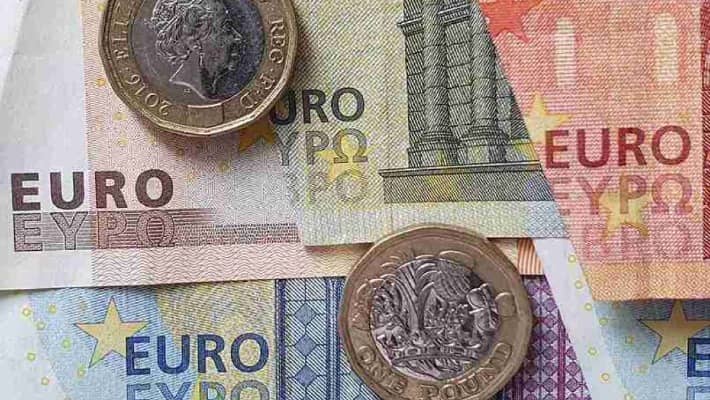Tuesday Jan 16 2024 03:57

11 min

The exchange rate between the Euro (EUR) and the British pound sterling (GBP) is an important economic indicator that can impact trade, investment, and travel between the UK and the Eurozone.
With the UK’s exit from the European Union, the EUR/GBP rate has experienced increased volatility as the economies adjust to new dynamics.
In this article, we’ll provide an overview of the Euro to GBP exchange rate, discuss what factors drive changes in the rate, and explain why the rate matters for consumers and businesses in both the UK and EU.
The Euro to British Pound exchange rate refers to how many British pounds (GBP) you would get for one Euro (EUR). It is typically shown as EUR/GBP, and the exchange rate constantly fluctuates in response to Forex market forces of supply and demand.
The EUR/GBP rate you see will depend on where you exchange your currencies. Banks, foreign exchange kiosks at airports, and online currency brokers will all quote slightly different rates.
The interbank market is where large banks exchange currencies with each other at wholesale rates. This sets the broader benchmark rate you see reported in financial news.
The Foreign exchange (Forex) market for euros and pounds is expansive, with millions traded daily. This huge volume makes the EUR/GBP rate highly liquid and dynamic.
When the UK or Eurozone economies strengthen or weaken, it affects the relative value of their currencies. For example, if the UK economy shows signs of decline, demand for pounds may fall, causing the EUR/GBP rate to rise.
Higher interest rates in one region make its currency more attractive to yield-seeking forex traders and investors. If the Bank of England raises UK rates, it could draw investment to the pound and cause the Euro to weaken.
High inflation typically causes a currency to depreciate. If inflation rises faster in the UK than in the Eurozone, the pound could weaken compared to the Euro.
Geopolitical events like Brexit or European debt crises can weaken demand for a currency and lower its value. Periods of instability tend to benefit “safe haven” currencies.
Trade imbalances can impact currency flows and exchange rates when the Eurozone and the UK predominately export to or import from each other.
Speculation, changing risk appetites, and economic outlooks can lead forex traders to buy or sell euros and pounds, swaying rates.
Actions and statements from the European Central Bank and Bank of England influence market expectations around interest rates and currency values. Quantitative easing also affects rates.
For further information, read this article: 6 Factors Affecting Forex Market Trading

To understand the potential volatility of the EUR/GBP exchange rate, it’s helpful to look at historical price movements:
This overview shows that the Euro to GBP exchange rate has often remained sensitive to political and economic events in the UK and the Eurozone.
Monetary policy divergence, growth trends, and geopolitical issues will likely continue driving exchange rate movements.
You might also like to read: How to Develop a Forex CFD Trading Plan
Changes in the EUR/GBP exchange rate have practical implications for both individuals and businesses engaged in international trade and travel between the Eurozone and the UK:
For UK exporters, a weaker pound makes British goods cheaper and more competitive in the EU market. But it also makes importing EU goods more expensive. The same dynamic applies in reverse for Eurozone exporters and importers.

A weaker pound tends to increase visits to the UK by Eurozone travellers taking advantage of a favourable exchange rate. But it reduces visits by Brits to the EU. Retail and hospitality sectors must adjust pricing and operations accordingly.
Large institutional investors with international asset holdings must consider how exchange rate moves impact their overall return. A depreciating pound can erode gains from British investments.
Multinational companies doing cross-border business face currency translation exposure. Sales and costs denominated in different currencies must be converted into a common currency for reporting.
In essence, the Euro to GBP exchange rate provides insights into the relative strength of the UK and Eurozone economies. Monitoring the rate helps businesses and policymakers make strategic financial and economic decisions.
Check this interesting article: Forex Trading - All You Need to Know and How to Begin.
If you regularly make transfers between euros and pounds or have business exposure to the cross rate, here are some tips for more easily tracking and converting amounts:
Staying on top of the Euro to GBP exchange rate requires timely market data and smart conversion practices.
But with an understanding of what moves the exchange rate, you can turn currency fluctuations to your advantage or at least mitigate associated risks.
The Euro to British Pound exchange rate is an important economic indicator that fluctuates based on many macroeconomic factors and provides insight into the relative strength of the UK and Eurozone economies.
Monitoring the exchange rate movements is crucial for individuals and companies engaged in trade, investment, and travel between the UK and EU. It helps time transactions properly, manage conversion costs, and make strategic financial decisions amid currency volatility.
Stay ahead with Forex news by choosing the best platform for trading.
Become a member of markets.com and access a cutting-edge trading platform!
“When considering “CFDs” for trading and price predictions, remember that trading CFDs involves a significant risk and could result in capital loss. Past performance is not indicative of any future results. This information is provided for informative purposes only and should not be considered investment advice.”